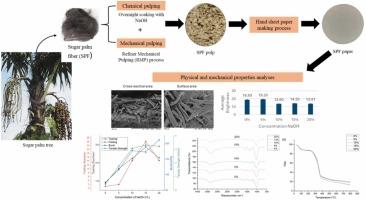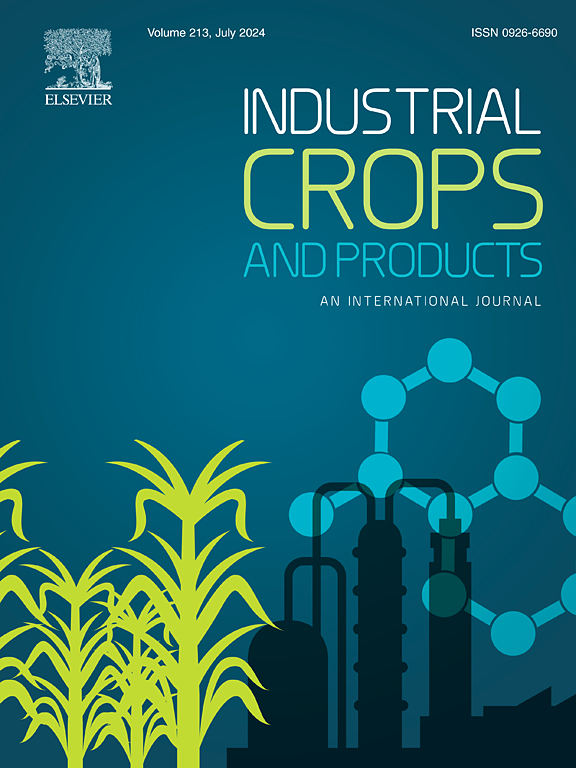Hybrid alkaline pulping enhances physiochemical, morphological, thermal, and mechanical properties of sugar palm fiber for papermaking
IF 6.2
1区 农林科学
Q1 AGRICULTURAL ENGINEERING
引用次数: 0
Abstract
As global paper demand accelerates, concerns over deforestation from traditional wood pulp production underscore the urgent need for sustainable alternatives. This study explores sugar palm (Arenga pinnata) fibers, an abundant by-product in Malaysia, as a promising renewable source for papermaking. The research aims to optimize sodium hydroxide (NaOH) treatment to enhance fiber properties by effectively removing hemicellulose and lignin while modifying hydroxyl groups. Sugar palm fibers were treated with NaOH concentrations ranging from 0 % to 20 % to assess impacts on key paper properties, including tensile strength, brightness, opacity, and thickness. The hybrid pulping process integrated NaOH immersion, room temperature treatment, and refined mechanical pulping, followed by Sommerville screening, spinning, and blending. Advanced characterization techniques, Scanning Electron Microscopy (SEM), X-ray Diffraction (XRD), Thermogravimetric Analysis (TGA), and Fourier-Transform Infrared Spectroscopy (FTIR), identified 15 % NaOH as the optimal concentration, yielding a 2.8 % increase in cellulose content, a 29.18 % rise in crystallinity index, and enhanced tensile strength to 2.86 kN/m. Thermal stability was also significantly improved, with degradation temperatures reaching 202.1°C and 580.2°C for the first and second degradation phases, respectively. These findings demonstrate that 15 % NaOH-treated sugar palm fibers present a viable, eco-friendly alternative to conventional wood pulp, contributing to sustainable advancements in the pulp and paper industry.

混合碱性制浆提高了造纸用糖棕榈纤维的理化、形态学、热学和力学性能
随着全球造纸需求的加速增长,人们对传统木浆生产中森林砍伐的担忧凸显了对可持续替代品的迫切需求。本研究探讨了糖棕榈(Arenga pinnata)纤维,它是马来西亚一种丰富的副产品,是一种很有前景的造纸可再生资源。研究旨在优化氢氧化钠(NaOH)处理,通过有效去除半纤维素和木质素,同时改变羟基来提高纤维性能。用浓度从 0% 到 20% 不等的 NaOH 处理糖棕榈纤维,以评估其对纸张主要性能的影响,包括抗张强度、白度、不透明度和厚度。混合制浆工艺综合了 NaOH 浸泡、室温处理和精制机械制浆,然后进行萨默维尔筛选、纺纱和混合。扫描电子显微镜 (SEM)、X 射线衍射 (XRD)、热重分析 (TGA) 和傅立叶变换红外光谱 (FTIR) 等先进的表征技术确定 15% 的 NaOH 为最佳浓度,使纤维素含量增加了 2.8%,结晶度指数提高了 29.18%,拉伸强度提高到 2.86 kN/m。热稳定性也有明显改善,第一和第二降解阶段的降解温度分别达到 202.1°C 和 580.2°C。这些研究结果表明,经过 15% NaOH 处理的糖棕榈纤维是传统木浆的一种可行的环保型替代品,有助于纸浆和造纸业的可持续发展。
本文章由计算机程序翻译,如有差异,请以英文原文为准。
求助全文
约1分钟内获得全文
求助全文
来源期刊

Industrial Crops and Products
农林科学-农业工程
CiteScore
9.50
自引率
8.50%
发文量
1518
审稿时长
43 days
期刊介绍:
Industrial Crops and Products is an International Journal publishing academic and industrial research on industrial (defined as non-food/non-feed) crops and products. Papers concern both crop-oriented and bio-based materials from crops-oriented research, and should be of interest to an international audience, hypothesis driven, and where comparisons are made statistics performed.
 求助内容:
求助内容: 应助结果提醒方式:
应助结果提醒方式:


